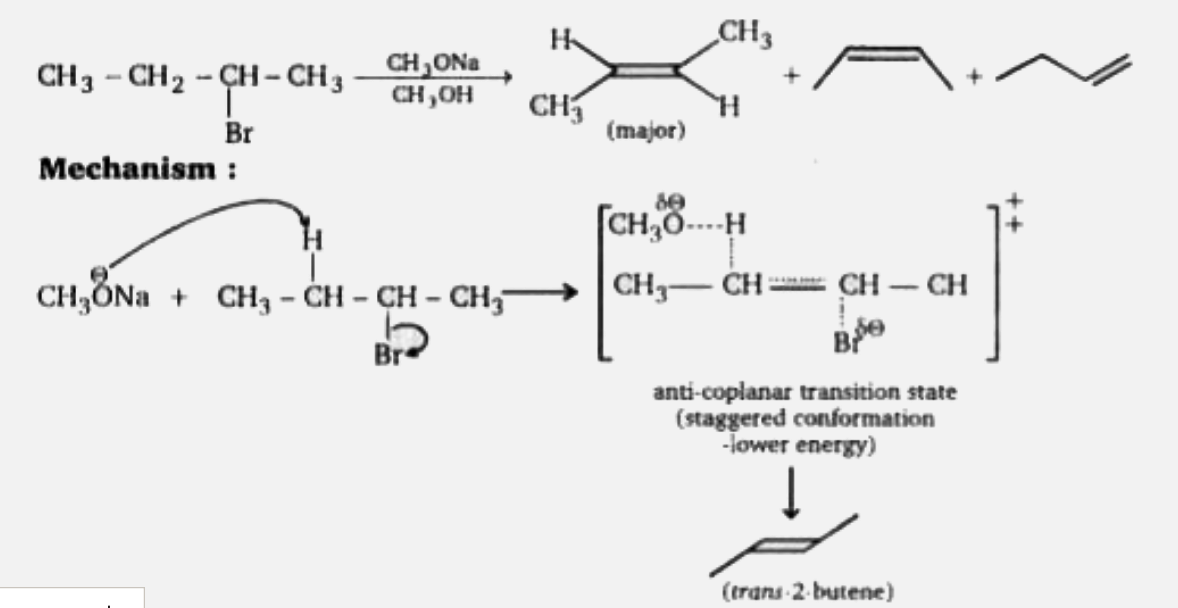Transition state 2 is structurally most likely as :
 Solution in Kannada
Solution in Kannada
intermediate 1
transition state 3
intermediate 2
product
The correct Answer is:C
Knowing something about the structure of a transition state is important when you are trying to predict the products of a reaction. The structure of the transition state lies between the structure ofthe reactants and the structure ofthe products. Butwhat do we mean by"between"? Does the structure ofthe transition state lie exactlyhalfwaybetween the structures of the reactants and products (as in 11, below), or does it resemble the reactants more closely than it resembles the products (as in I), or is it more like the products than the reactants (as in Ill)?

According to the Hammond postulate, the transition statewill be more similarinstructure to the species that it is more similar to in energy. In the case ofan exergonic reaction, the transition state is more similar in energy to the reactant than to the product. (curve I). Therefore, the structure ofthe transition state will more closely resemble the structure of the reactantthanthatofthe transition statewill more closelyresemble the structure ofthe reactantthanthatofthe product. In anendergonicreaction (curve III), thetransitionstate is more similar in energy to the product, so the structure ofthe transition state will more closely resemble the structure of the product. Only when the reactant and the product have identical energies (curve Il) would we expect the structure ofthe transition state to be halfway between the structures ofthe reactant and the product.

Nowwe can understand whythe tert-butyl cation is formed faster than the isobutyl cation when 2-methylpropene reacts with HC!. Of the two possible products, the tert-butyl cation (a tertiary carbocation) is more stable than the isobutyl cation (a primary carbocation). Because formation ofa carbocation is an endergonic reaction, the structure ofthe transition state will resemble the structure ofthe carbocation product. This means thatthe transition statewill have a significant amountofpositive charge on a carbon. The same factors that stabilize the positively charged product will stabilize the partially positively charged transition state. Therefore, the transition state leading to the tert-butyl cation is more stable than the transition state leading to the isobutyl cation, so the tert-butyl cation will be formed faster. It is important to keep in mind thatthe amount of positive charge inthe transitionstateis notas greatas the amountofpositive charge inthe transitionstateis notas great as the amountofpositive charge inthe carbocationproduct, so the difference in the stabilities of the two transition states is not as great as the difference in the stabilities ofthe two carbocation products.
Topper's Solved these Questions
- ALKYL HALIDES (SUBSTITUTION REACTIONS)BOOK - MS CHOUHANCHAPTER - ALKYL HALIDES (SUBSTITUTION REACTIONS)EXERCISE - LEVEL-2
41 Videos
- ALKYL HALIDES (ELIMINATION REACTION) BOOK - MS CHOUHANCHAPTER - ALKYL HALIDES (ELIMINATION REACTION) EXERCISE - LEVEL-2
25 Videos
- AMINESBOOK - MS CHOUHANCHAPTER - AMINESEXERCISE - Level-2
1 Videos
Similar Questions
Statement - 1 : Nucleophilicity order in polar-protic solvent is I−<Br−<Cl−<F−
Statement-2 : Due to bigger size of I it is less solvated in polar-protic solvent.
View SolutionComprehension
E2 raction → Elimination bimolecular
In the general mechanism of the E2 reaction a strong base abstract a proton on a carbon atom adjacent to the one of the leaving group. As the abstracts a proton , a double bond forms and the leaving group leaves.

Identify the rate of reaction of given compounds in E2 reaction:

View SolutionFive amine syntheses are outlined below. In each reaction box enter a single letter designating the best reagent and conditions selected from the list at the bottom of the page.


View SolutionIn general, the Transition elements exhibit their highest oxidation states in their compounds with elements like:
View SolutionTransition state structure of the substrate formed during an enzymatic reaction is
View SolutionWhich of the following structures is most likely for XeOF4 ?
View SolutionTransition state structure of the substrate formed during an enzymatic reaction is
View SolutionIn a H-like sample, electrons make transition from 4^(th) excited state upto 2^(nd) state. Then ,
View SolutionTransition state structure of the substrate formed during an enzymatic reaction is
View SolutionThe stable oxidation state likely to be shown by first row transition metals is
View SolutionTransition state structure of the substrate formed during an enzymatic reaction is
View SolutionThe most likely representation of resonance structure of p-nitrophenoxide is :
View SolutionTransition metals show zero oxidation state with ligands like CO. Explain.
View SolutionState the areas where acid rains are most likely.
View SolutionThe most common oxidation state of first transition series is +2 . Explain.
View SolutionThe most common oxidation state of first transition series is +2 . Explain.
View Solution
